Welcome to North Sinai, one of Egypt’s most remarkable birding destinations. Here, you will find a variety of birds, both resident and migratory, that make this area their home. You can find a range of species in North Sinai, from small finches to large raptors.
The Mediterranean and desert climates make this area an ideal habitat for a wide range of species. The variety of habitats, from the high mountains of Jabal Halal to the low-lying Wadi El-Arish, provides a great opportunity for birders to observe different species.
With a bit of luck and a lot of patience, you may even be able to spot some of the rarer species. So explore the skies of North Sinai and see what you can find!
10 Birds to Watch in North Sinai
North Sinai, a region in Egypt, offers birdwatching enthusiasts the opportunity to observe various avian species. Here are 10 birds to watch for in North Sinai:
1. Greater Flamingo
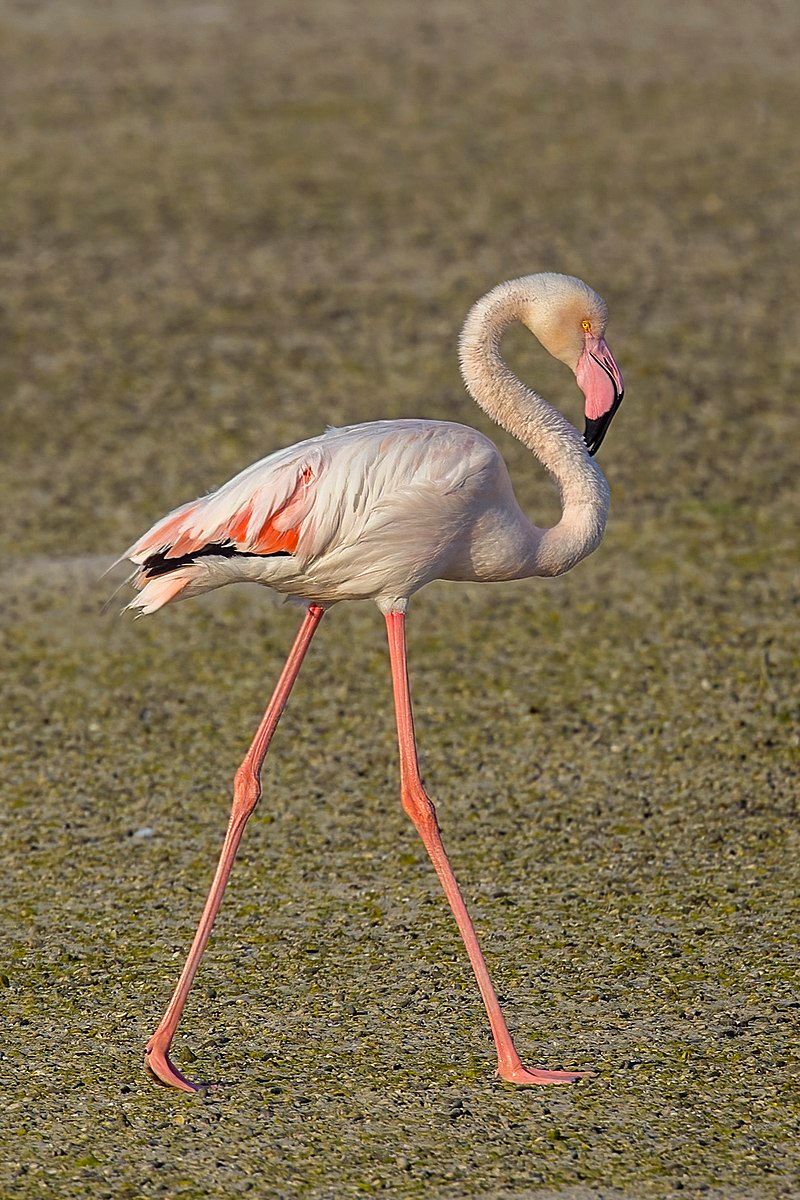
The greater flamingo is an impressive bird species that can be found all around the world.
It is the largest and most widespread of its family and is commonly found in the Old World, particularly in Northern and Sub-Saharan Africa, the Indian Subcontinent, the Middle East, the Levant, the Persian Gulf, the Gulf of Aden, the Red Sea, and the Mediterranean countries of Southern Europe.
The greater flamingo is a large bird, reaching a height of up to 1.5m and a weight of up to 4kg.
It has a long neck, pinkish-white plumage, and a black beak. It prefers to live in shallow, salty, and warm lakes, lagoons, and estuaries.
They feed on small aquatic organisms, such as crustaceans, molluscs, and aquatic vegetation. The greater flamingo is a social bird, forming large flocks in their habitats. They can be seen in large groups in the same area during mating season.
They are also quite vocal, with various calls used for different occasions and purposes. The greater flamingo is an important species for conservation, as it is a key component of a number of unique habitats around the world.
It is also a popular avian species, with many zoos, bird sanctuaries, and wildlife parks featuring them in their displays.
| Kingdom | Animalia |
| Phylum | Chordata |
| Class | Aves |
| Order | Phoenicopteriformes |
| Family | Phoenicopteridae |
| Genus | Phoenicopterus |
| Species | P. roseus |
2. Common Redshank
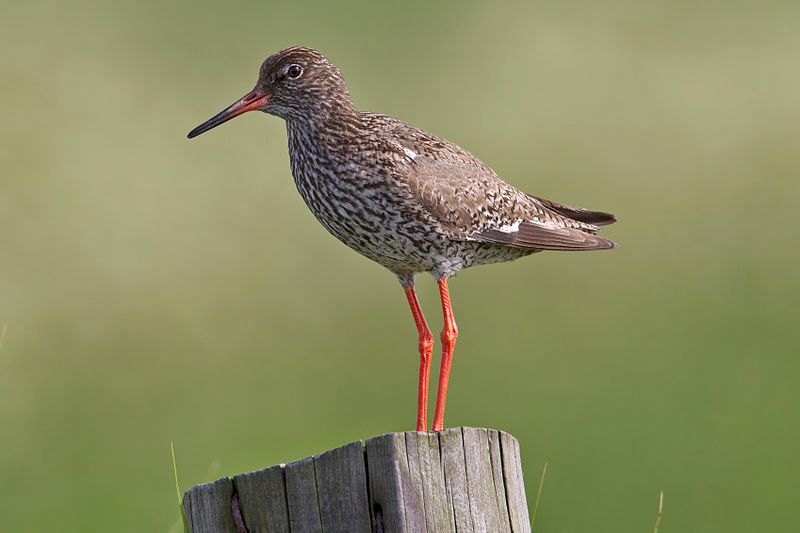
The common redshank is a species of wader, a bird typically inhabiting wetlands or coastal habitats. It is native to Eurasia and is a member of the large family Scolopacidae, which includes other species such as the sandpiper, plover, and snipe.
The redshank is easily identified by its reddish-brown plumage, which gives the bird its name. It also has long, yellow legs and a black-tipped bill.
It is a medium-sized bird, typically measuring around 28-30 cm long. The common redshank is a migratory species, with populations in some parts of Europe and Asia wintering in Africa and other parts of the southern hemisphere.
It feeds on various small animals, such as insects, worms, and crustaceans, which it finds in shallow waters.
It is also known to take fish and has even been observed catching frogs and small mammals on occasion. The redshank is a social species, often forming large flocks when not breeding.
It nests in colonies, typically laying between two and four eggs in a shallow scrape on the ground. The chicks are downy when born and leave the nest within a few days.
The species is not currently considered to be threatened, although its population may decline due to habitat destruction and pollution.
| Kingdom | Animalia |
| Phylum | Chordata |
| Class | Aves |
| Order | Charadriiformes |
| Family | Scolopacidae |
| Genus | Tringa |
| Species | T. totanus |
3. Black Stork
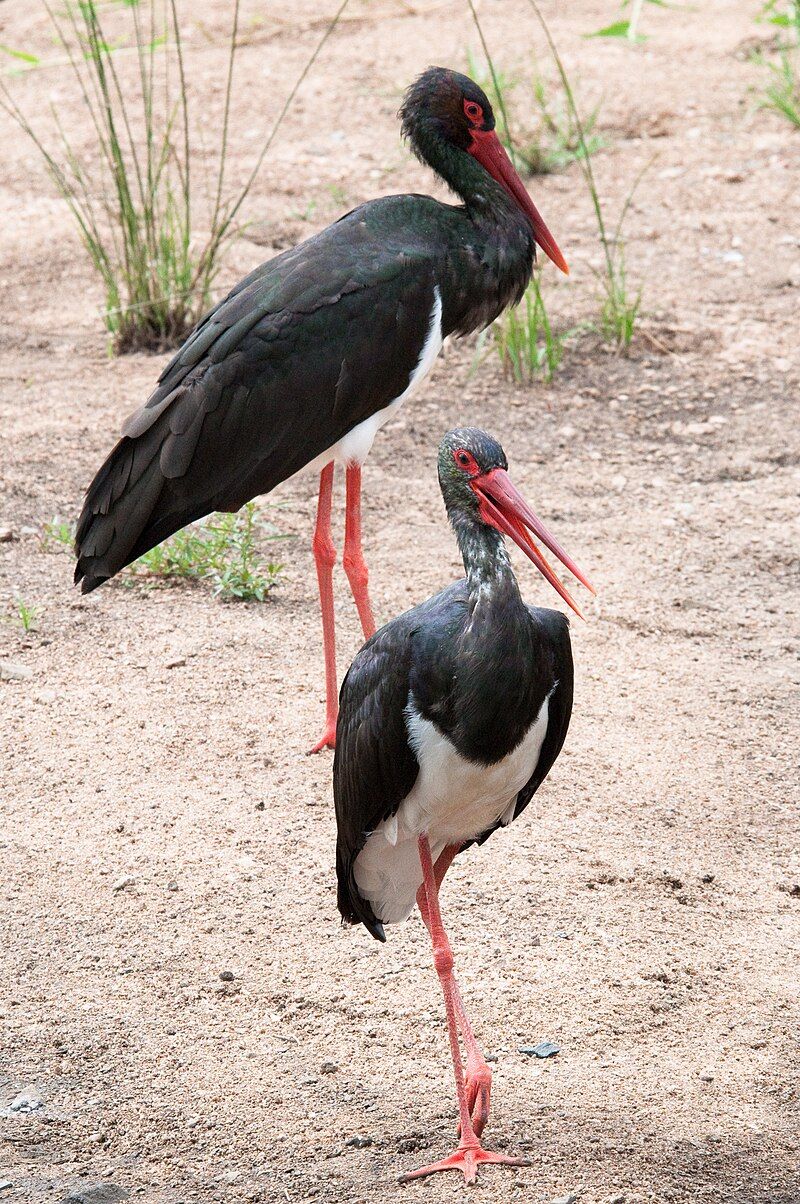
The black stork is a species of stork that is found in many parts of the world. It is a large bird with a wingspan of up to 1.5 meters. It belongs to the Ciconiidae family of birds, which includes other species of storks, such as the marabou stork and the white stork.
The famous Swedish naturalist Carl Linnaeus first scientifically described the black stork in the 10th edition of his book Systema Naturae.
This book is an important reference work for biologists and zoologists, as it contains a systematic description of the species living in the world at the time.
In particular, Linnaeus described the black stork in great detail, cataloguing its physical characteristics and its geographical distribution.
Today, the black stork is still recognized as a distinct species and is considered to be a vulnerable species by the International Union for Conservation of Nature.
| Kingdom | Animalia |
| Phylum | Chordata |
| Class | Aves |
| Order | Ciconiiformes |
| Family | Ciconiidae |
| Genus | Ciconia |
| Species | C. nigra |
4. Gadwall
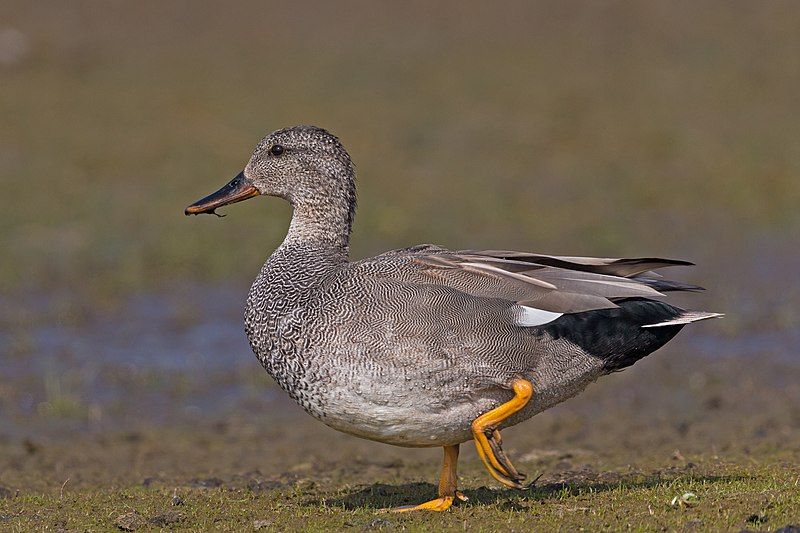
The gadwall is a species of dabbling duck that belongs to the family Anatidae, which includes ducks, geese, and swans. It is a migratory species in temperate and subarctic regions across the Northern Hemisphere.
The gadwall is a medium-sized duck, with males measuring around 20-26 inches in length and weighing 1.5-2.5 pounds, while females measure around 18-24 inches in length and weighing 1-2 pounds.
Gadwall typically has slate-grey bodies with light-coloured bellies, white secondary feathers, and a black tail.
The head is grey with a white patch behind the eye and a yellow bill. The male’s head is darker than the female’s and has a white stripe at the back.
During the breeding season, the male’s head turns darker grey, and the bill turns orange-yellow. Gadwalls typically feed on vegetation, such as grasses, sedges, aquatic plants, insects, crustaceans, and molluscs.
They are usually seen foraging in shallow waters close to shorelines.
They also congregate in large flocks during migration and on wintering grounds. Gadwalls are generally considered to be a common and widespread species, and their populations have been stable in recent years.
They are found across North America, Europe, and Asia and are considered to be of least concern on the IUCN Red List of Threatened Species.
| Kingdom | Animalia |
| Phylum | Chordata |
| Class | Aves |
| Order | Anseriformes |
| Family | Anatidae |
| Genus | Mareca |
| Species | M. strepera |
5. European Turtle Dove
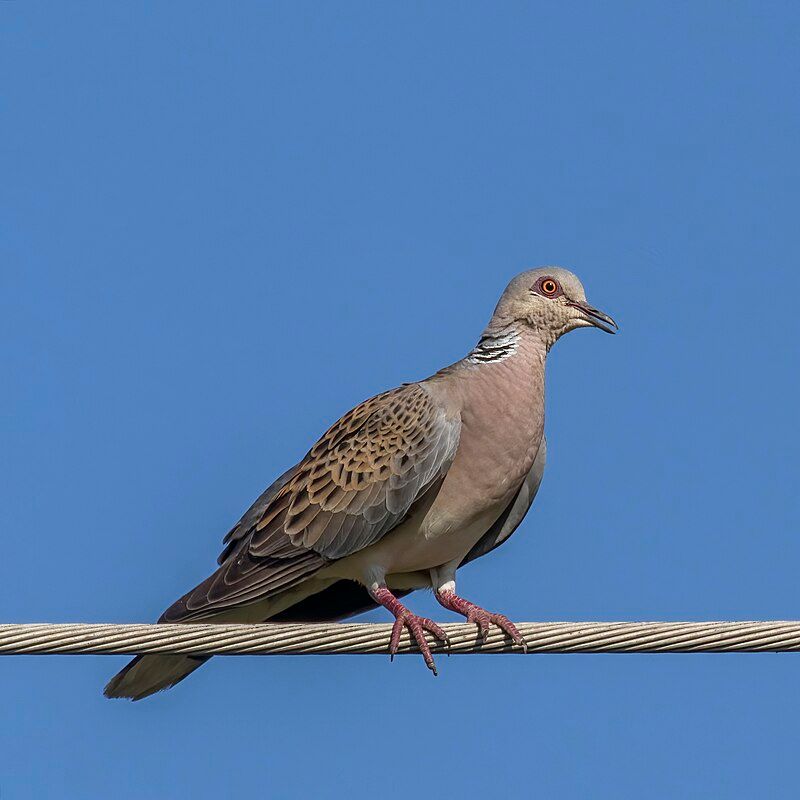
The European turtle dove is a species of bird that belongs to the Columbidae family, which comprises doves and pigeons.
This particular species has a wide range, spanning across the southwestern part of the Palearctic, which covers parts of North Africa, and it migrates to the northern parts of Sub-Saharan Africa in winter.
This bird typically breeds in the summer months, when the conditions are more favourable. The European turtle dove is a small, slender bird with a grey-brown body, black and white markings, and a white rump. Its wings are long and pointed, and its tail is short and rounded.
Its call is a series of low purrs, which can be heard during its breeding season. The European turtle dove’s diet mainly consists of seeds, grains and some insects, which it finds by foraging in fields and gardens.
It normally nests in trees or shrubs and builds its nest from twigs and grass. The female typically lays two eggs, which are incubated by both parents for up to two weeks.
The chicks fledge after around two weeks and can fly within a few weeks of hatching. The European turtle dove is an important species for conservation since its numbers are in decline due to habitat destruction, hunting and the use of pesticides.
The International Union for Conservation of Nature (IUCN) lists it as a species of Least Concern.
| Kingdom | Animalia |
| Phylum | Chordata |
| Class | Aves |
| Order | Columbiformes |
| Family | Columbidae |
| Genus | Streptopelia |
| Species | S. turtur |
6. Northern Lapwing
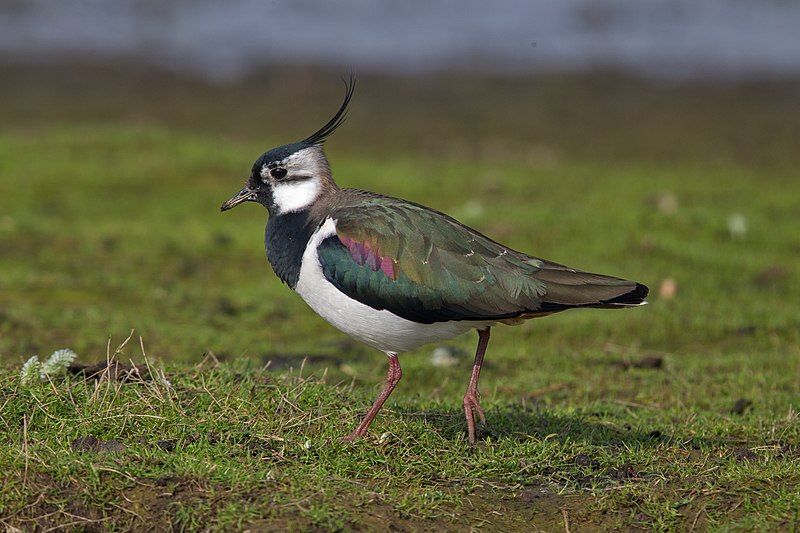
The northern lapwing is a type of bird found across temperate Eurosiberia. It is a member of the lapwing subfamily and is also widely known by several other names such as peewit or pewit, tuit or twit, green plover, and eye wipe.
It is a fairly common bird throughout this region and can usually be seen in open fields and grasslands. Its most distinctive feature is the large crest of feathers on its head, which it can raise when it feels threatened.
Its wings have a black-and-white pattern, making it easy to spot while flying. The northern lapwing feeds mainly on insects, worms, and other invertebrates, and it often gathers in large flocks during migration.
It is an important part of the local ecosystem, providing valuable pest control services.
| Kingdom | Animalia |
| Phylum | Chordata |
| Class | Aves |
| Order | Charadriiformes |
| Family | Charadriidae |
| Genus | Vanellus |
| Species | V. vanellus |
7. Kentish Plover
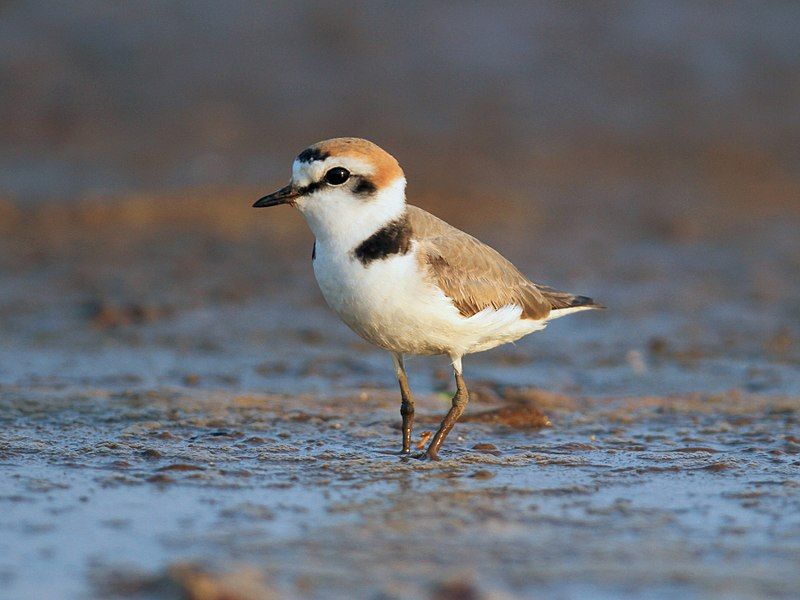
The Kentish Plover is a species of shorebird found all over the world. It is small in size and belongs to the family Charadriidae.
This species breeds near coasts, lagoons, and saline lakes and can be found in a number of different habitats, including sand dunes, marshes, semi-arid deserts, and tundra. These birds are migratory, moving to different areas according to the season.
In the summer, they are found in areas with open sandy or stony beaches, mudflats, and salt marshes. In the winter, they move to warmer climates in the southern hemisphere. They feed mainly on small invertebrates and crustaceans.
The Kentish Plover is an important species in many coastal ecosystems and is an indicator of the health of those environments.
| Kingdom | Animalia |
| Phylum | Chordata |
| Class | Aves |
| Order | Charadriiformes |
| Family | Charadriidae |
| Genus | Charadrius |
| Species | C. alexandrinus |
8. White-Tailed Lapwing
The white-tailed lapwing, or white-tailed plover, is a type of wader from the lapwing family. The scientific name of this species is Vanellus leucurus.
This name was derived from Medieval Latin, with the genus name Vanellus meaning “lapwing” and coming from the word vannus, which means “winnowing fan”.
The specific name leucurus is from Ancient Greek and translates to “white-tailed”.This lapwing species is medium-sized and known for having long legs and a relatively long bill. This combination of features gives it an elegant and graceful appearance.
The white-tailed lapwing is also known for its unique white-tinged wings. These wings are a distinguishing feature and help to distinguish it from other species of lapwing further. The white-tailed lapwing is a migratory species found in Europe, Asia, and Africa.
In Europe, it is a common breeding species in Scotland and Ireland and is seen as far south as Spain and Portugal. During the winter, most of the population migrates to Africa, where it can be found from Senegal to Ethiopia.
The white-tailed lapwing is a species of conservation concern due to its declining population numbers. Its preferred habitats, such as wet grasslands and marshes, are being destroyed and degraded due to agricultural intensification and urban development.
As a result, the population of the white-tailed lapwing is decreasing. Therefore, conservation efforts are needed in order to protect this species and its habitats.
| Kingdom | Animalia |
| Phylum | Chordata |
| Class | Aves |
| Order | Charadriiformes |
| Family | Charadriidae |
| Genus | Vanellus |
| Species | V. leucurus |
9. Red-Billed Tropicbird
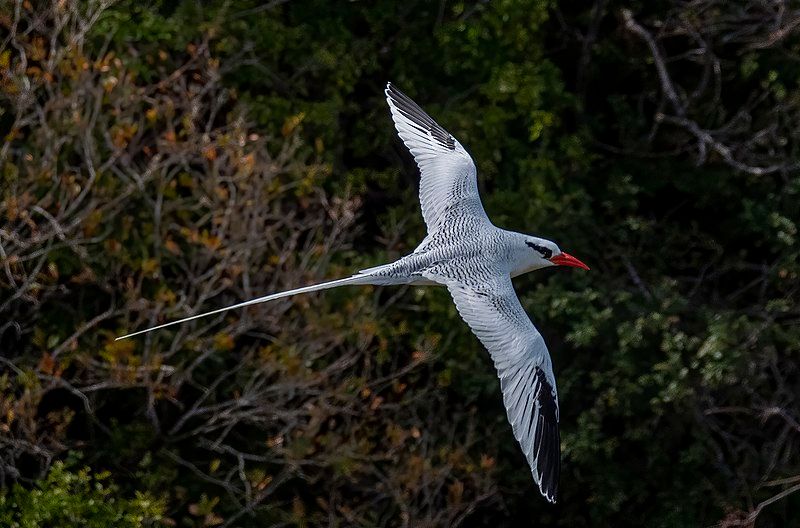
The red-billed tropicbird is a seabird species inhabiting tropical oceans around the world. It is one of three closely related species of tropicbird, the other two being the white-tailed tropicbird and the red-tailed tropicbird.
The red-billed tropicbird superficially resembles a tern, having mostly white plumage with some black markings on the wings and back and a black mask. Its common name comes from its most distinctive feature: a bright red bill.
The red-billed tropicbird can be found in tropical areas worldwide, including the Caribbean, the Indian Ocean, and the Pacific Ocean.
It is a graceful and graceful flyer and can often be seen soaring high in the sky, using its long wings to soar up and catch the wind.
The red-billed tropicbird is also known for its elaborate mating rituals, in which the male will perform a courtship display in order to attract a mate.
The red-billed tropicbird is a beautiful and unique seabird species that is worth learning more about.
| Kingdom | Animalia |
| Phylum | Chordata |
| Class | Aves |
| Order | Phaethontiformes |
| Family | Phaethontidae |
| Genus | Phaethon |
| Species | P. aethereus |
10. Great Bittern
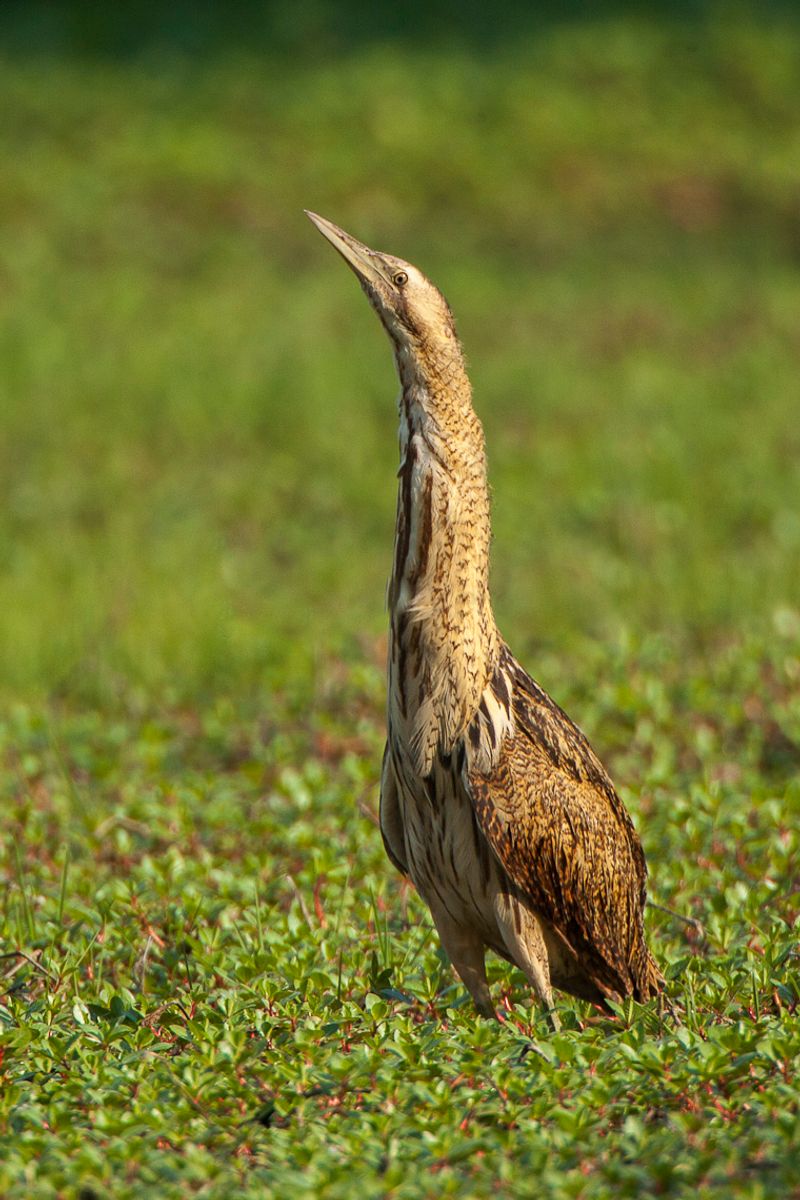
The Eurasian bittern, also known as the great bittern, is a wading bird of the heron family Ardeidae. It belongs to the bittern subfamily and is distributed in two distinct geographical regions.
The northern race is found in Europe, the Palearctic region, and the northern coast of Africa, while the southern race is only found in southern Africa.
The Eurasian bittern is a medium-sized heron with a body length of up to 60 cm and a wingspan of up to 1.2 m.
It has a brownish-grey plumage with dark spots and streaks, and its head and neck are blackish in colour. Its bill is yellowish-orange, and its legs are yellowish-green. The Eurasian bittern feeds mainly on small fish, frogs, and other aquatic creatures.
It can be found in marshy and reed-bed habitats, where it builds its nest in thick vegetation.
It is mostly silent, but it can produce a deep booming call during the breeding season. The Eurasian bittern is an important species for conservation, as it is declining in many parts of its range. Its main threats are habitat destruction and disturbance from human activities.
The species is listed as vulnerable on the IUCN Red List and is protected by international and national laws.
| Kingdom | Animalia |
| Phylum | Chordata |
| Class | Aves |
| Order | Pelecaniformes |
| Family | Ardeidae |
| Genus | Botaurus |
| Species | B. stellaris |
Conclusion
Birds in North Sinai are an important part of the region’s biodiversity and contribute significantly to the region’s ecological balance.
These birds are threatened by human activities such as poaching, habitat destruction, and pollution, and it is important to protect them for future generations.
With proper management and conservation efforts, these birds can continue to provide important ecosystem services and be enjoyed by people for generations to come.